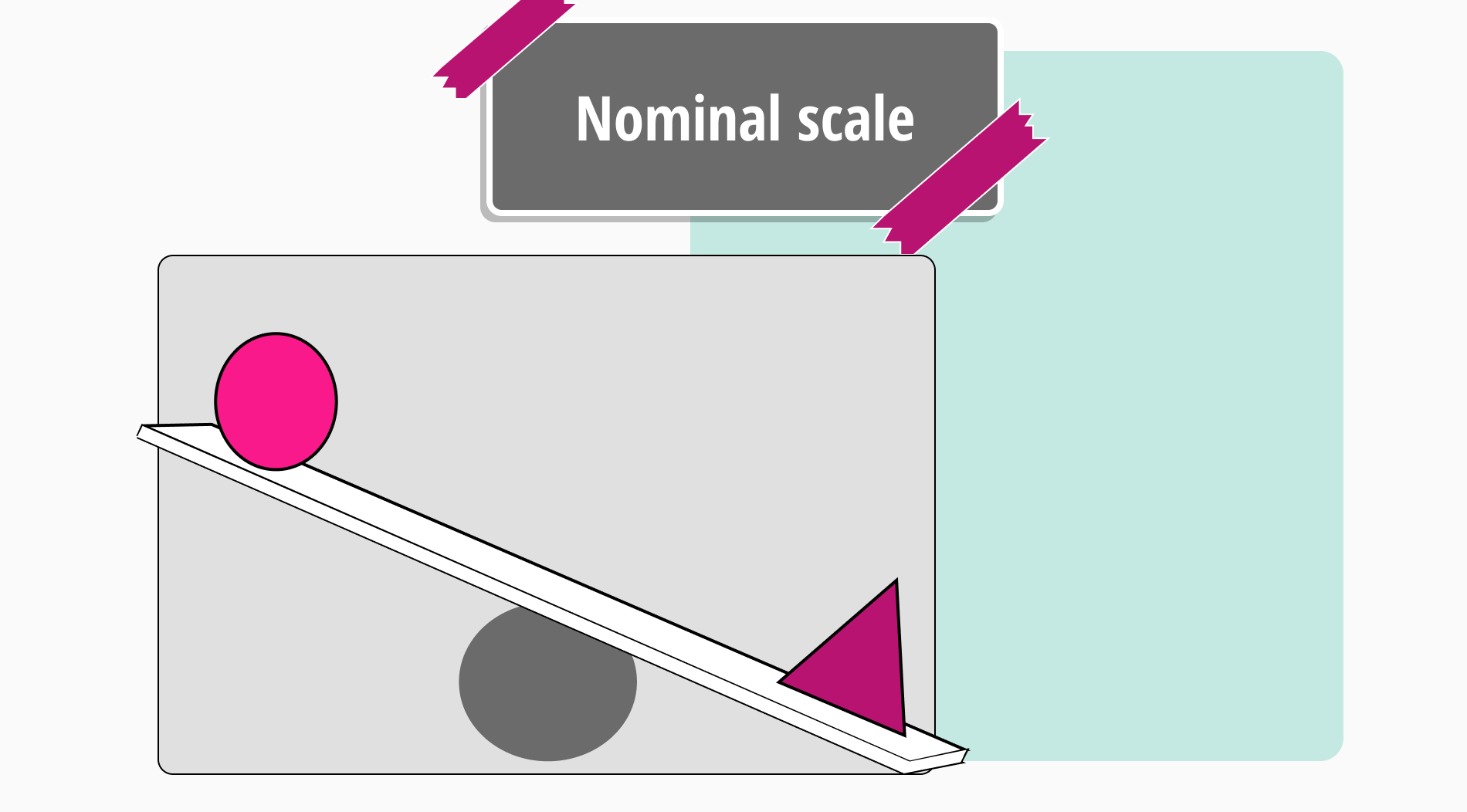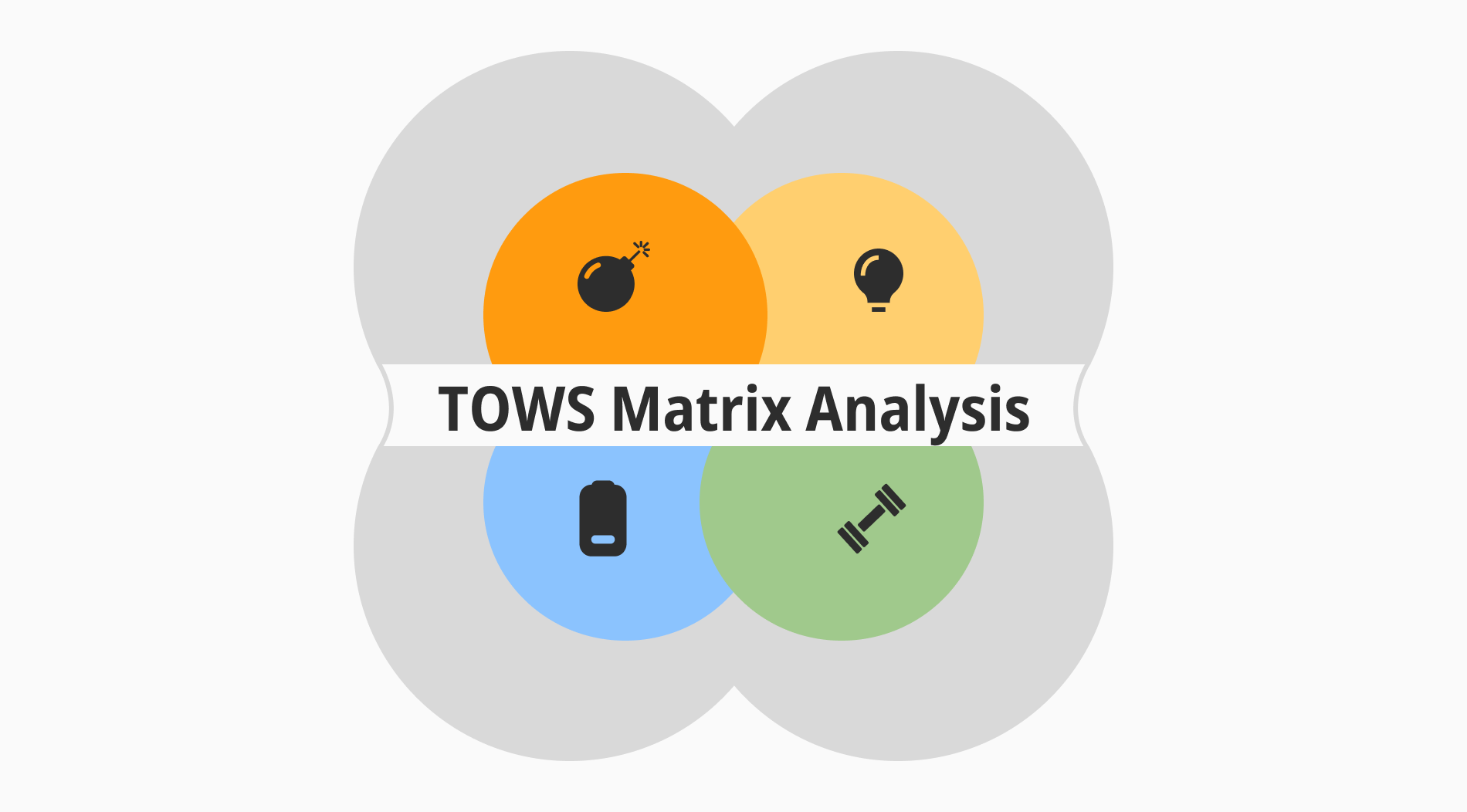
In today's rapidly evolving business landscape, strategic planning tools and models serve as critical compasses. They guide organizations through complex terrain. These tools offer clarity amidst uncertainty, enabling businesses to identify opportunities, mitigate risks, and chart courses for success. From SWOT analysis to scenario planning, these frameworks provide invaluable insights, empowering companies to navigate change and thrive in dynamic environments.
Today, we will dive into the comprehensive exploration of the TOWS Matrix analysis, a potent strategic planning tool. This article will delve into its methodology, comparisons with similar tools, real-world examples, advantages and disadvantages, ideal applications, and frequently asked questions. By the end, you'll have a solid grasp of this invaluable tool for organizational strategy development.
Let’s start with the basics: What is the TOWS matrix analysis?

The TOWS Matrix, also known as the TOWS Strategic Alternatives Matrix, is a strategic planning tool that analyzes the external opportunities and threats facing an organization and its internal strengths and weaknesses.
It helps organizations identify strategic options by matching strengths with opportunities, weaknesses with threats, and vice versa.
This matrix provides a structured framework for strategic analysis and decision-making. It enables organizations to develop proactive strategies that leverage their strengths and opportunities while addressing weaknesses and mitigating threats. By systematically evaluating both internal and external factors, the TOWS Matrix helps organizations align their resources and capabilities with the external environment. It enhances their strategic agility and competitive advantage.
The TOWS Matrix is a valuable tool for strategic planning and organizational development. It provides a systematic approach to strategic analysis. It also enables organizations to identify key strategic options and make informed decisions that align with their goals. Whether used in business, government, or non-profit sectors, the TOWS Matrix helps organizations navigate complex strategic challenges and capitalize on emerging opportunities.
TOWS matrix analysis: Explained
The TOWS Matrix analysis, a.k.a TOWS analysis, is a strategic planning tool that helps organizations identify strategic options. It does that by evaluating their internal Strengths and Weaknesses against external Opportunities and Threats.
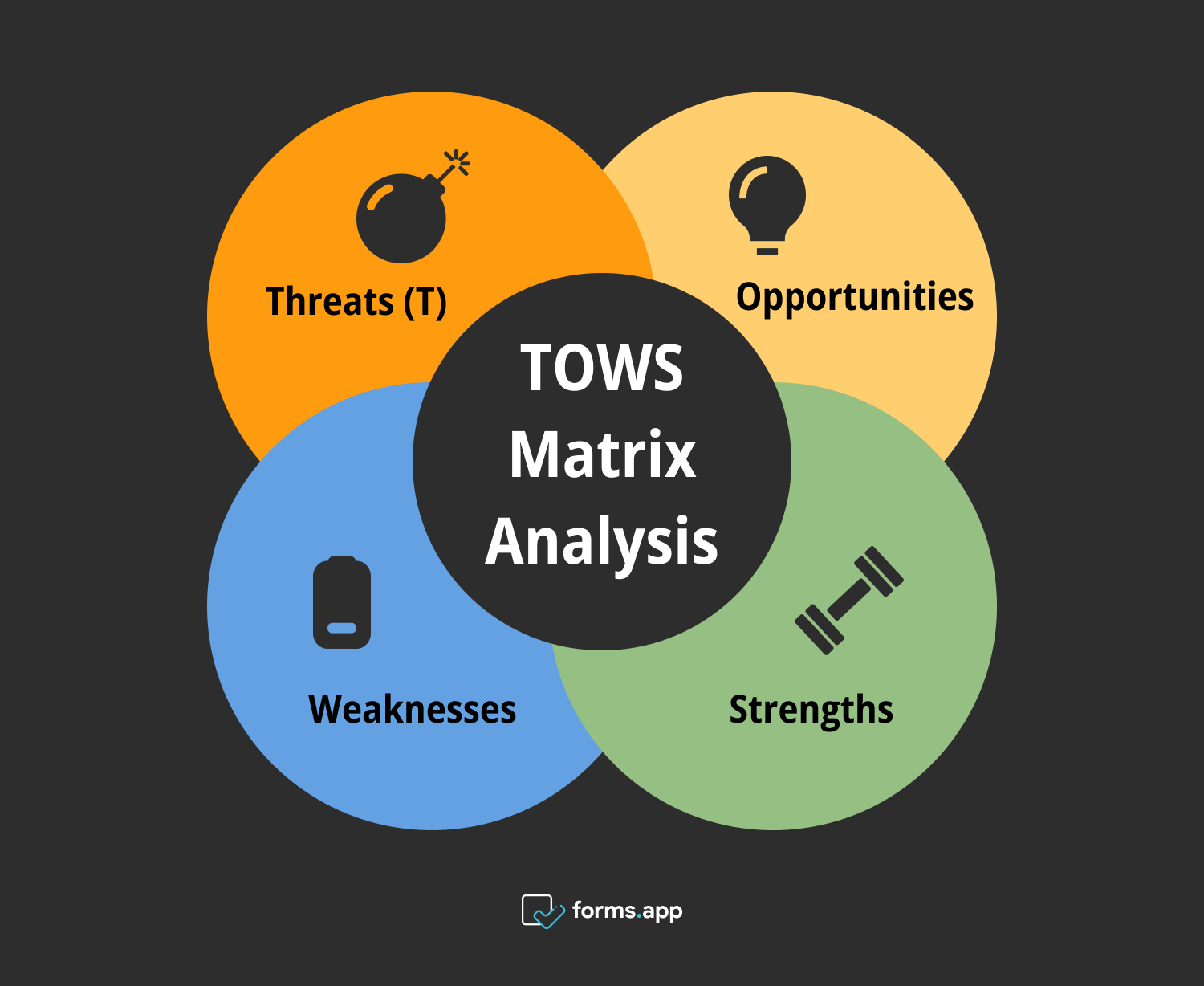
TOWS Matrix template
It involves creating a matrix to match internal factors (Strengths and Weaknesses) with external ones (Opportunities and Threats). This results in strategic insights and actionable recommendations. Let's delve into each component:
1- Threats (T)
These external factors or challenges could pose risks to an organization's success or stability. Examples include competitive pressures, economic downturns, regulatory changes, or shifts in consumer behavior. Identifying threats enables organizations to proactively manage risks, adapt to changing environments, and implement strategic measures to safeguard their interests and sustain long-term.
2- Opportunities
These external factors or situational analysis could positively impact an organization's performance or growth. Examples include market trends, emerging technologies, industry changes, or new consumer preferences. Recognizing the advantage of opportunities allows organizations to capitalize on favorable circumstances, expand their market reach, and drive innovation to stay ahead of the competition.
3- Weaknesses
These internal factors hinder an organization's performance or competitiveness. Examples may include a lack of resources, outdated technology, poor management practices, or limited market presence. Identifying weaknesses is crucial for organizations to address areas of improvement, enhance operational efficiency, and mitigate potential risks to their success.
4- Strengths
These are internal attributes or resources that give an organization a competitive advantage. Examples include a skilled workforce, a strong brand reputation, advanced technology, and efficient processes. Leveraging strengths enables organizations to excel in their respective industries, outperform competitors, and achieve strategic objectives more effectively.
TOWS: An Expansion of SWOT
The TOWS matrix expands upon the basic principles of SWOT analysis. It does so by introducing a more comprehensive and strategic approach to planning. SWOT analysis provides a snapshot of an organization's internal strengths and weaknesses, as well as external opportunities and threats.
The TOWS matrix takes this analysis a step further. It emphasizes the relationships between these factors and encourages organizations to develop specific strategies based on these interactions.
One key difference between TOWS and SWOT analysis lies in their strategic focus. SWOT analysis primarily identifies internal and external factors affecting an organization, whereas the TOWS matrix goes beyond identification to propose actionable strategies. It analyzes how to leverage or mitigate internal strengths and weaknesses in response to external opportunities and threats. The TOWS matrix enables organizations to develop more targeted and effective strategic plans.
How to use the TOWS matrix analysis
There are several steps to follow in the TOWS matrix analysis. By following these steps, you can conduct a successful TOWS matrix analysis. You can also identify internal and external factors, and generate strategies. And, you can evaluate and prioritize them.
Here are these steps:
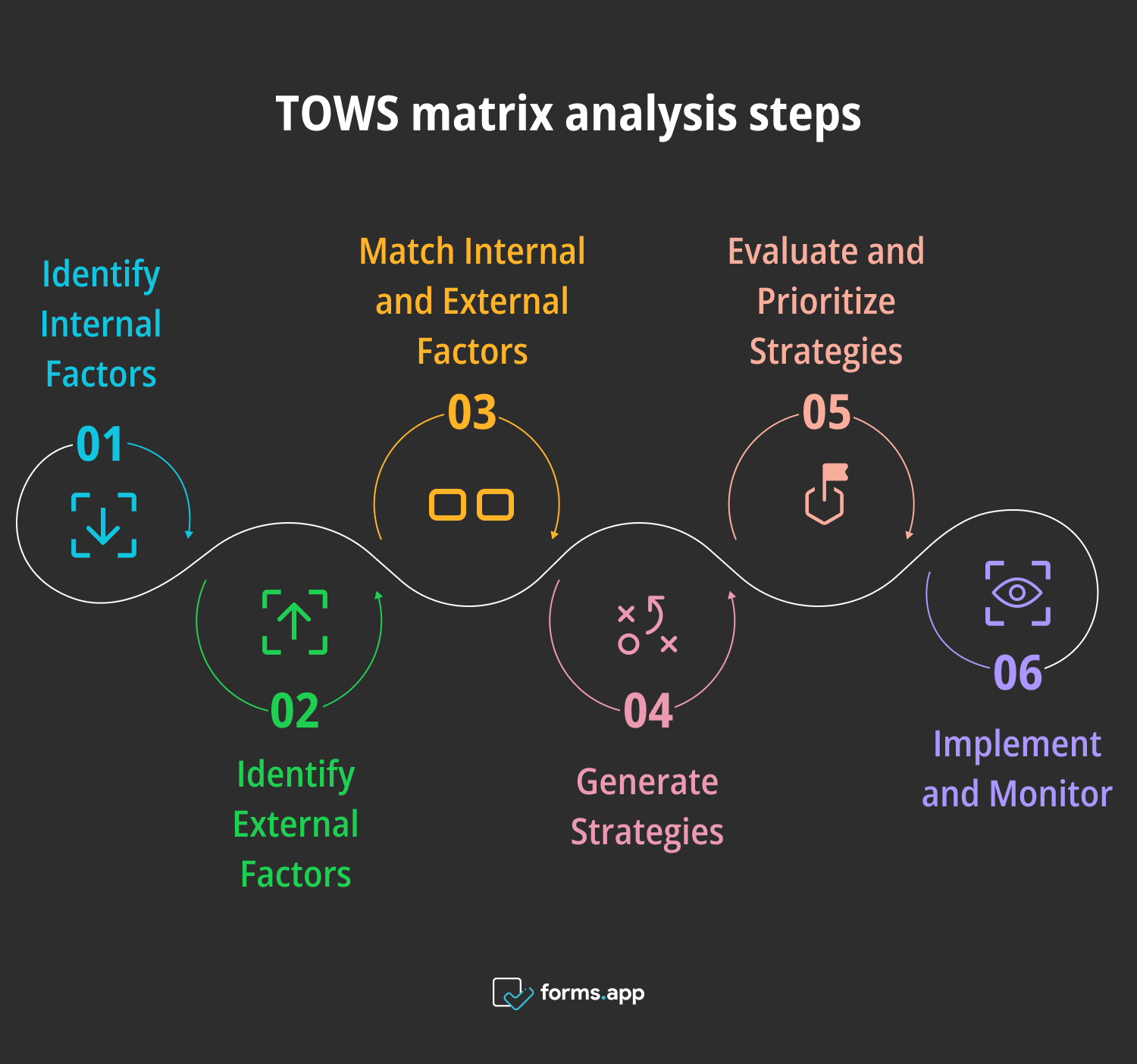
Steps of TOWS matrix analysis
1. Identify Internal Factors
Begin by conducting a comprehensive assessment of your organization's internal strengths and weaknesses. This involves analyzing its resources, capabilities, and core competencies. Understanding what your organization excels at and where it faces challenges provides valuable insights for strategic planning.
2. Identify External Factors
Shift your focus outward to evaluate the external factors influencing your organization's operations. This includes analyzing market trends, competitive dynamics, and regulatory changes. By understanding these external influences, you can identify potential opportunities for growth and avoid threats to your organization's success.
3. Match Internal and External Factors
Utilize the TOWS matrix to match internal strengths with external opportunities (SO strategies). You can also match internal strengths with external threats (ST strategies), internal weaknesses with external opportunities (WO strategies), and internal weaknesses with external threats (WT strategies). This strategic matching process helps identify actionable strategies tailored to your organization's unique circumstances.
4. Generate Strategies
Based on the matched factors identified in the TOWS matrix, brainstorm specific strategies for each quadrant. These strategies should leverage internal strengths to capitalize on external opportunities, mitigate internal weaknesses to address external threats, and maximize your organization's competitive advantage.
5. Evaluate and Prioritize Strategies
Assess the possibility, potential impact, and alignment of each strategy with your organization's goals and resources. Prioritize strategies that offer the greatest potential for success and are feasible to implement within your organization's constraints. This ensures that your efforts on initiatives align with your overall strategic objectives.
6. Implement and Monitor
Once you have selected the strategies, implement them effectively and establish mechanisms for monitoring their progress. Regularly evaluate the performance of implemented strategies and make adjustments as needed. This is to ensure they remain aligned with your organization's goals and responsive to changing market conditions. Continuous monitoring and adaptation are key to driving successful outcomes.
SWOT vs. TOWS matrix analysis
There are many frameworks from SOAR analysis to PESTEL analysis. TOWS analysis is one of those frameworks and actually has a cousin, called SWOT analysis. Here, let’s take a look at the differences and similarities of the TOWS and SWOT models. The comparison will help you understand these models better.
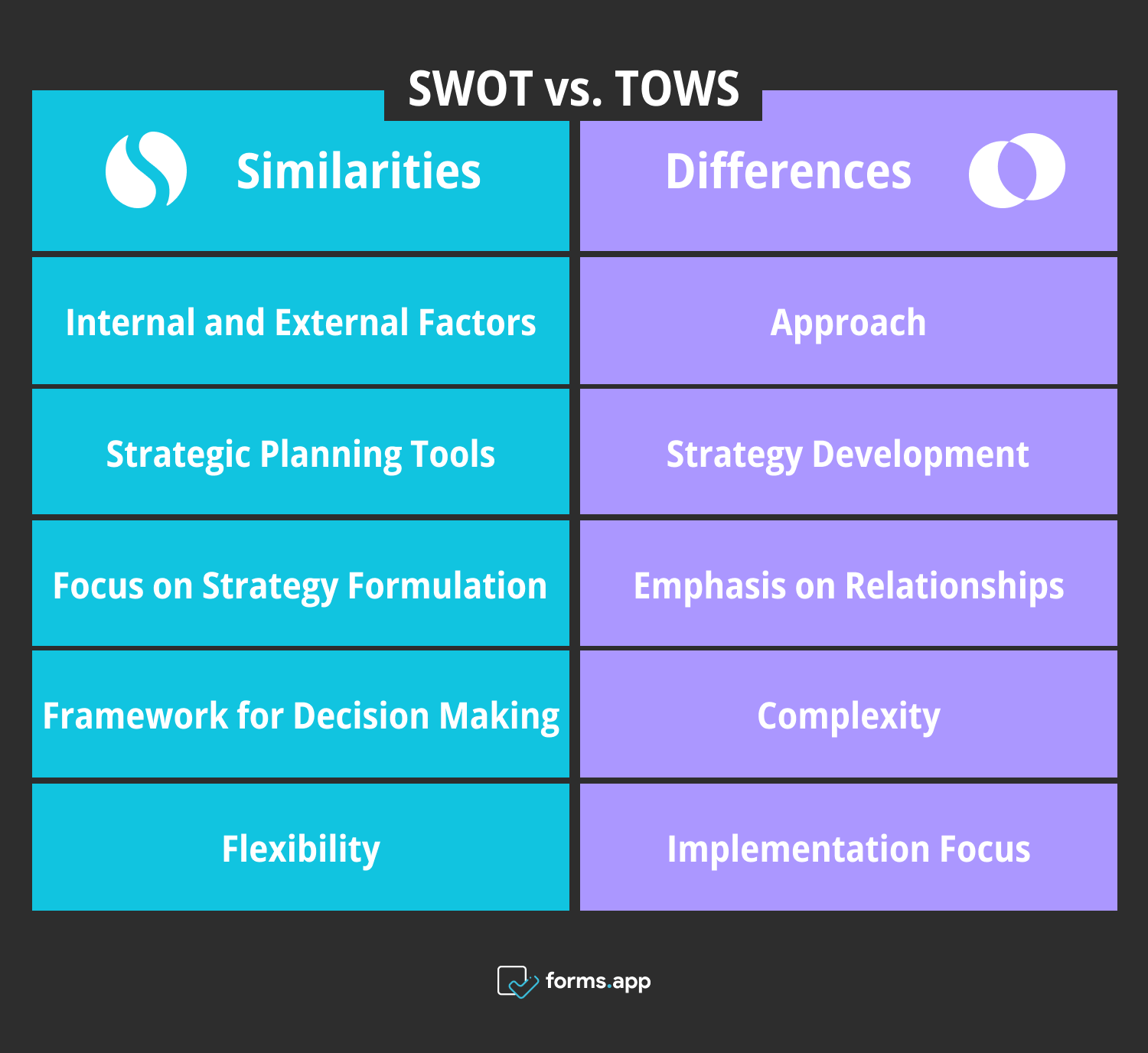
SWOT vs TOWS analysis
Similarities
- Internal and External Factors: Both SWOT and TOWS analyses consider internal strengths and weaknesses, as well as external opportunities and threats.
- Strategic Planning Tools: Both are strategic planning tools used to assess an organization's current position and develop strategies for the future.
- Focus on Strategy Formulation: Both analyses focus on formulating strategies based on the identified factors to achieve organizational objectives.
- Framework for Decision Making: Both provide a structured framework for decision-making by highlighting key factors influencing the organization.
- Flexibility: Both SWOT and TOWS analyses offer flexibility in terms of customization and adaptation to different organizational contexts and objectives.
Differences
- Approach: SWOT analysis focuses on identifying strengths, weaknesses, opportunities, and threats separately, while TOWS analysis integrates these factors to develop specific strategies.
- Strategy Development: SWOT analysis primarily involves listing factors without necessarily developing actionable strategies, whereas TOWS analysis emphasizes the development of strategic alternatives based on the analysis.
- Emphasis on Relationships: TOWS analysis places more emphasis on the relationships between internal and external factors. It identifies how to use strengths to capitalize on opportunities, and how to mitigate weaknesses against threats.
- Complexity: TOWS analysis is generally more complex and comprehensive compared to SWOT analysis due to its integrated approach and focus on strategy formulation.
- Implementation Focus: While SWOT analysis is for assessing current situations and generating ideas, TOWS analysis is more focused on developing specific action plans and strategies for implementation.
Examples of TOWS analysis
Now, let's delve into two scenarios to gain a deeper understanding of the TOWS matrix analysis in action. By exploring how different companies apply this strategic tool, we can better grasp its practical implications and effectiveness. It will especially help us understand it within the context of driving organizational decision-making and strategic planning. Here are the TOWS analysis examples:
1- Company A (Retail)
In Company A, a retail chain facing stiff competition in the market, a TOWS analysis revealed several strategic insights. Leveraging its strengths in customer service and brand loyalty, the company identified the opportunity to expand its online presence. By investing in e-commerce platforms and digital marketing, Company A capitalized on the growing trend of online shopping. Therefore, they have boosted sales and market share.
However, the analysis also highlighted weaknesses in inventory management and outdated technology, posing threats to its competitiveness. To address this, the company implemented inventory optimization strategies and upgraded its point-of-sale systems. These initiatives improved operational efficiency and customer experience. They also mitigate weaknesses and reduce the impact of external threats such as changing consumer preferences and market saturation.
Through comprehensive TOWS analysis, Company A strategically aligned its robust internal strengths, such as skilled personnel and innovative technology. They have done that by promising external opportunities while proactively mitigating potential threats. This synergistic approach not only bolstered profitability but also fortified its position in the market, ensuring sustained growth and resilience amidst industry dynamics.
2- Company B (Technology)
In Company B, a technology startup operating in a rapidly evolving industry, a TOWS analysis identified opportunities to leverage its innovative products and agile development processes. The company has focused on its strengths in technology expertise and product innovation. It has pursued partnerships with larger firms to expand its market reach and access new resources.
However, the analysis also revealed weaknesses in marketing and customer support, posing threats to its growth potential. To address this, Company B invested in marketing campaigns and enhanced customer service capabilities, improving brand visibility and customer satisfaction. These efforts strengthened its competitive position and mitigate threats such as increased competition and market volatility.
Through strategic alignment of its internal strengths, such as a talented workforce and cutting-edge technology, with external opportunities, Company B adeptly maneuvered through the intricacies of the technology sector. This deliberate approach fueled growth and innovation within its market niche. It cemented its position as a leader in the ever-evolving tech landscape.
TOWS analysis advantages and disadvantages
Now, we will explore the advantages and disadvantages of the TOWS matrix analysis. Let's acknowledge its role as a strategic planning tool. Understanding its potential benefits and drawbacks is essential for making informed decisions and maximizing its utility in organizational decision-making processes. Here are some of the positive and negative impacts:
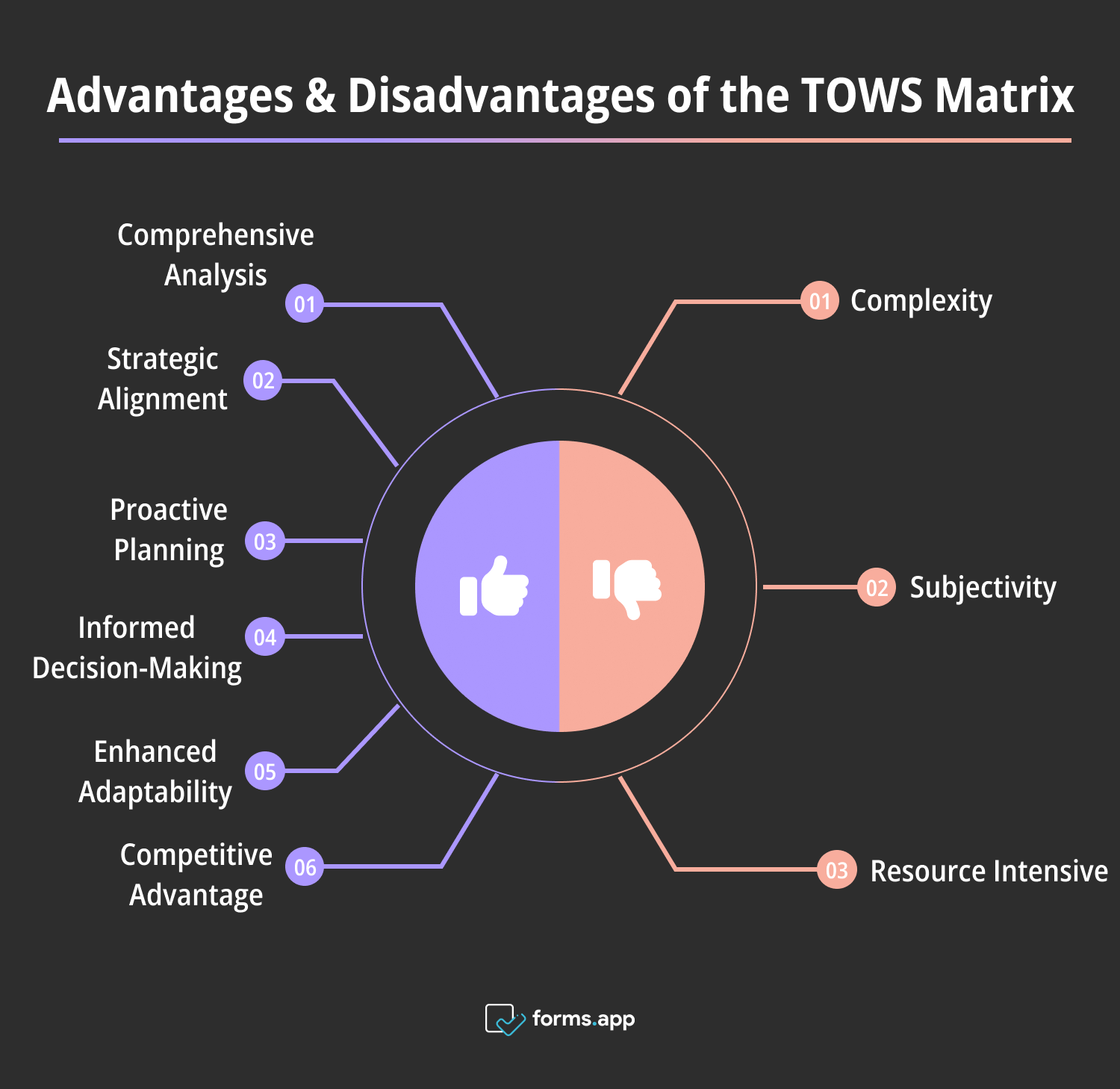
Pros and Cons of the TOWS Matrix
1- Advantages
- Comprehensive Analysis: TOWS analysis offers a comprehensive evaluation of internal strengths and weaknesses, as well as external opportunities and threats. It also provides a holistic view of the strategic landscape.
- Strategic Alignment: It helps align organizational strategies with internal capabilities and external market dynamics. It ensures that strategic initiatives are well-suited to achieve organizational goals.
- Proactive Planning: TOWS analysis enables organizations to proactively identify potential challenges and opportunities. This allows them to develop proactive strategies to capitalize on strengths and mitigate weaknesses.
- Informed Decision-Making: By systematically assessing internal and external forces, TOWS analysis facilitates informed decision-making. It enables organizations to make strategic choices based on data-driven insights.
- Enhanced Adaptability: TOWS analysis encourages organizations to adapt to changing market conditions by identifying emerging opportunities and threats. It fosters adaptability and resilience in the face of uncertainty.
- Competitive Advantage: Utilizing TOWS analysis can provide organizations with a competitive edge. It helps them leverage their strengths to exploit market opportunities while mitigating potential risks and threats.
2- Disadvantages
- Complexity: TOWS analysis can be complex and time-consuming. It may require significant resources and expertise to conduct effectively, which may pose challenges for organizations with limited capabilities or experience.
- Subjectivity: The interpretation of internal and external factors in TOWS analysis may be subjective. It can suffer from individual biases or organizational perspectives, potentially leading to biased or inaccurate strategic assessments.
- Resource Intensive: Implementing TOWS analysis requires substantial resources, including time, personnel, and financial investment. This may not be feasible for all organizations, particularly smaller enterprises with limited resources.
When to use the TOWS matrix analysis
Now, let’s discover the suitable environments for the TOWS analysis. It's crucial to recognize the TOWS matrix in strategic management. Identifying the suitable contexts for its application ensures effective decision-making and maximizes its potential to drive organizational success. You can see the TOWS work in different contexts, such as the following:
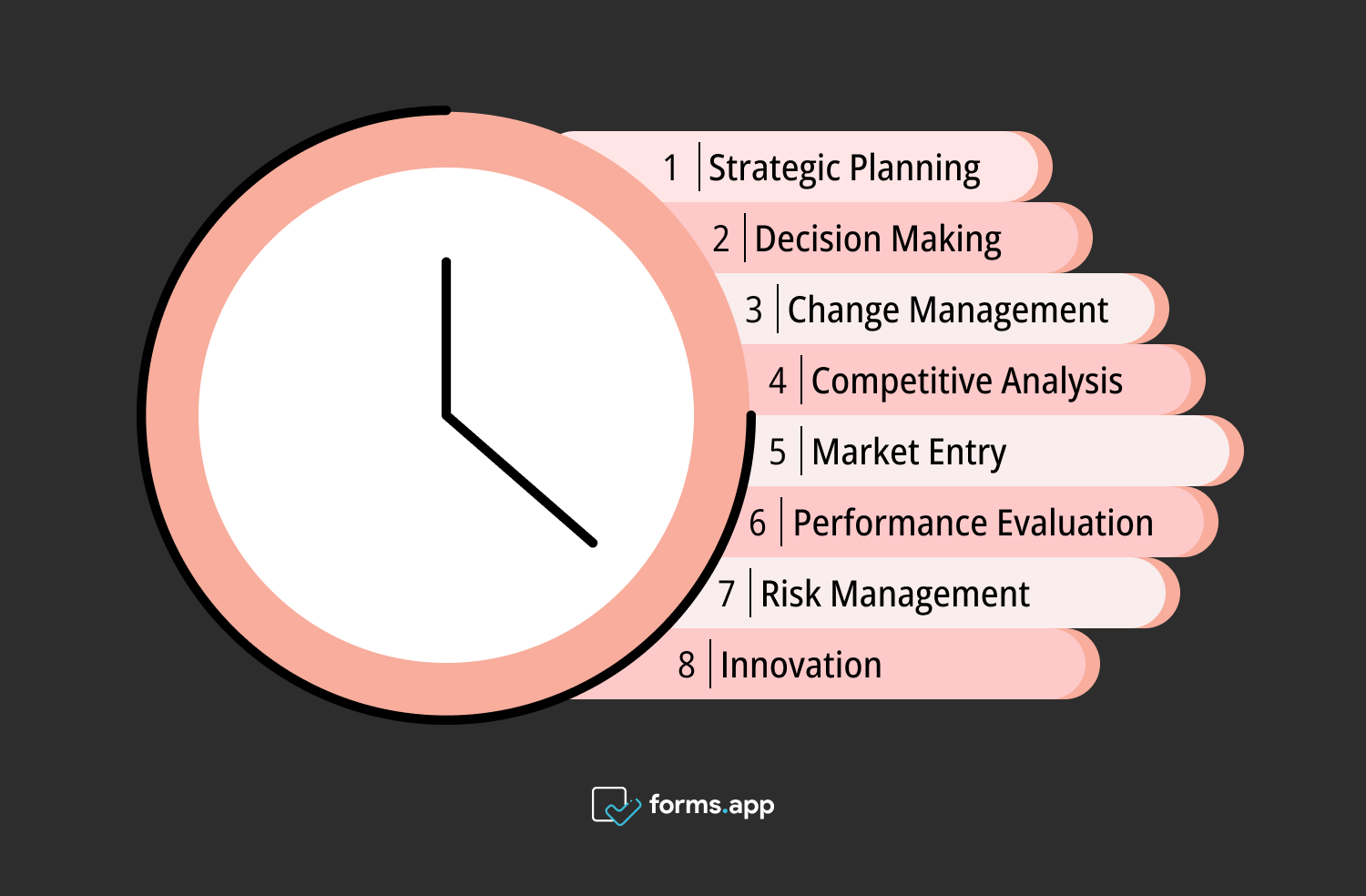
Right times to use TOWS matrix analysis
⏰Strategic Planning: Employ TOWS analysis during comprehensive strategic planning processes. Do this to meticulously evaluate and strategize around the internal strengths and weaknesses. Also, consider the external opportunities and threats facing the organization.
⏰Decision Making: Use TOWS analysis as a robust decision-making tool. You can carefully assess and weigh the implications of internal and external factors on pivotal business decisions. This ensures informed and strategic choices.
⏰Change Management: Implement TOWS analysis as part of change management initiatives to thoroughly analyze the organizational landscape. You can also identify potential barriers and facilitators to change and develop targeted strategies for successful implementation.
⏰Competitive Analysis: Apply TOWS analysis to conduct an exhaustive competitive analysis. Meticulously examine competitors' strengths, weaknesses, opportunities, and threats to glean actionable insights and inform strategic positioning.
⏰Market Entry: Employ TOWS analysis to conduct a meticulous evaluation of potential new markets. Assess the compatibility of internal capabilities with external market dynamics to inform informed market entry strategies.
⏰Performance Evaluation: Use TOWS analysis as a robust performance evaluation tool to conduct a comprehensive assessment of organizational performance. Identify key areas of strength and improvement to drive strategic redirection and improvement initiatives.
⏰Risk Management: Implement TOWS analysis as part of a comprehensive risk management strategy. This will enable you to systematically identify, evaluate, and mitigate risks arising from both internal vulnerabilities and external threats. It also ensures proactive risk mitigation measures.
⏰Innovation: Apply TOWS analysis to foster a culture of innovation within the organization. Leverage internal strengths to capitalize on emerging market opportunities and technological advancements. Drive sustainable growth and competitive advantage.
Frequently asked questions about the TOWS matrix analysis
Let's now address some of the most frequently asked questions about the TOWS matrix analysis. By clarifying these questions, we can deepen our understanding of its advantages and application in strategic decision-making processes. These frequently asked questions are as follows:
TOWS Matrisi, kuruluşların dahili güçlü ve zayıf yönlerinin yanı sıra dış fırsat ve tehditleri değerlendirmeleri için sistematik bir çerçeve sunan güçlü bir stratejik planlama aracıdır. İşletmeler kapsamlı bir TOWS analizi yaparak stratejik konumları hakkında değerli bilgiler edinebilirler. Ayrıca potansiyel stratejik seçenekleri belirleyebilir ve fırsatlardan yararlanmak ve riskleri azaltmak için etkili stratejiler formüle edebilirler.
Hem SWOT (Güçlü Yönler, Zayıf Yönler, Fırsatlar, Tehditler) hem de TOWS (Tehditler, Fırsatlar, Zayıf Yönler, Güçlü Yönler) analizleri bir kuruluşu etkileyen iç ve dış faktörleri değerlendirir. Yaklaşım ve uygulama açısından farklılık gösterirler. SWOT analizi dahili güçlü ve zayıf yönler ile dış fırsat ve tehditlerin belirlenmesine odaklanır.
TOWS analizi ise SWOT analizini bir adım öteye taşıyarak kurum içi güçlü yönleri kurum dışı fırsatlarla, zayıf yönleri tehditlerle ve tam tersi şekilde stratejik olarak hizalar. TOWS analizi, bu stratejik hizalamalara dayalı olarak eyleme geçirilebilir stratejilerin formüle edilmesini sağlar. Bu da onu SWOT analizine kıyasla daha proaktif ve dinamik bir stratejik planlama aracı haline getirmektedir.
TOWS matrisini hazırlamak için kuruluşunuzun dahili güçlü ve zayıf yönlerinin kapsamlı bir analizini yaparak işe başlayın. Şirketinizin üstün olduğu ve zorluklarla karşılaşabileceği kilit alanları belirleyin. Ardından, işinizi etkileyebilecek fırsatları ve tehditleri belirlemek için dış ortamı analiz edin. Bu bilgileri topladıktan sonra bir matris oluşturun.
Bu matris, stratejik seçenekleri belirlemenize ve güçlü yönlerinizden yararlanmak için eyleme geçirilebilir stratejiler geliştirmenize yardımcı olacaktır. Aynı zamanda zayıflıkları ele almanızı, fırsatlardan yararlanmanızı ve tehditleri etkili bir şekilde azaltmanızı sağlayacaktır. Değişen pazar dinamiklerine uyum sağlamak için TOWS matrisini düzenli olarak gözden geçirin ve güncelleyin. Stratejik girişimlerinizin geçerliliğini sağlayın.
TOWS matrisi dört stratejik yaklaşımı kapsar. SO stratejileri, dış fırsatlardan yararlanmak için kurum içi güçlü yönlerden yararlanır. WO Stratejileri, dış fırsatları değerlendirerek iç zayıflıkların üstesinden gelir ve büyümeyi mümkün kılar.
ST Stratejileri, dış tehditleri azaltmak için güçlü iç yönleri kullanır ve rekabetçi esneklik sağlar. WT Stratejileri dış tehditleri azaltmak için iç zayıflıkları ele alır ve kurumsal istikrarı korur.
Conclusion
In conclusion, the TOWS matrix analysis is a strategic planning tool that helps organizations identify and prioritize key factors affecting their performance. By following its steps, understanding its advantages, and recognizing suitable environments for its use, businesses can make informed decisions to achieve their goals.
We've delved deep into the TOWS matrix, understanding its steps, perks, examples, and where it's best used. Answering FAQs, we've equipped you with the tools to apply them effectively. Now, equipped with this knowledge, businesses can tackle strategic decisions with clarity and confidence, propelling growth and success. Create your own TOWS analysis template now!
Fatih is a content writer at forms.app and a translator specializing in many text domains, including medical, legal, and technical. He loves studying foreign languages. Fatih especially likes to create content about program management, organizational models, and planning tools.
İçindekiler
- Let’s start with the basics: What is the TOWS matrix analysis?
- TOWS matrix analysis: Explained
- How to use the TOWS matrix analysis
- SWOT vs. TOWS matrix analysis
- Examples of TOWS analysis
- TOWS analysis advantages and disadvantages
- When to use the TOWS matrix analysis
- Frequently asked questions about the TOWS matrix analysis
- Conclusion



 9 dakikalık okuma
9 dakikalık okuma
